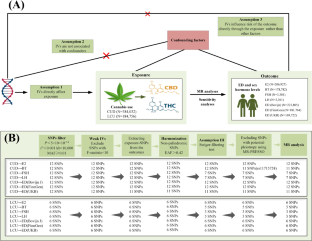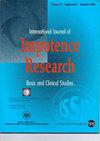使用大麻对勃起功能障碍和性激素的影响:孟德尔随机分析。
IF 2.5
3区 医学
Q2 UROLOGY & NEPHROLOGY
引用次数: 0
摘要
以往的研究强调了吸食大麻(CU)与勃起功能障碍(ED)风险增加之间的联系,这可能是由于大麻对性激素平衡的间接影响。然而,相关证据仍存在争议,因果关系也不明确。本研究利用全基因组关联研究(GWAS)数据,通过孟德尔随机化(MR)分析,研究了大麻使用障碍(CUD)、终生使用大麻(LCU)和勃起功能障碍以及性激素水平(包括雌二醇(E2)、生物可用睾酮(BT)、卵泡刺激素(FSH)和黄体生成素(LH))之间的因果关系。主要分析方法是反方差加权法(IVW)。芬兰基因和英国生物库的数据被用于复制和荟萃分析。结果表明,基因预测的 CUD(OR = 0.97,95% CI 0.87-1.10,P = 0.66)和 LCU(OR = 1.13,95% CI 0.84-1.50,P = 0.42)与 ED 风险之间没有因果关系。荟萃分析提供了一致的证据(P > 0.05)。04-0.09,P = 0.46)、FSH(CUD:β = 0.01,95% CI -0.18-0.20,P = 0.92;LCU:β = 0.01,95% CI -0.44-0.47,P = 0.95)和 LH(CUD:β = 0.01,95% CI -0.18-0.21,P = 0.90;LCU:β = 0.13,95% CI -0.22-0.49,P = 0.46)。敏感性分析没有发现水平多向性或异质性的证据,确保了结果的稳健性。总之,该 MR 分析未提供证据支持 CU 与 ED 或性激素水平之间的因果关系。本文章由计算机程序翻译,如有差异,请以英文原文为准。


The impact of cannabis use on erectile dysfunction and sex hormones: a Mendelian randomization analysis
Previous study has highlighted an association between cannabis use (CU) and an increased risk of erectile dysfunction (ED), potentially due to indirect effects on sex hormonal balance. However, the evidence remains controversial, and the causal relationship is unclear. This study utilized genome-wide association study (GWAS) data to investigate the causal relationships between cannabis use disorder (CUD), lifetime cannabis use (LCU), and ED, as well as levels of sex hormones including estradiol (E2), bioavailable testosterone (BT), follicle-stimulating hormone (FSH), and luteinizing hormone (LH) through Mendelian randomization (MR) analysis. The primary method of analysis was the inverse variance weighted (IVW) method. Data from the FinnGen and UK Biobank were used for replication and meta-analysis. The results indicated no causal relationship between genetically predicted CUD (OR = 0.97, 95% CI 0.87–1.10, P = 0.66) and LCU (OR = 1.13, 95% CI 0.84–1.50, P = 0.42) with the risk of ED. The meta-analysis provided consistent evidence (P > 0.05). No causal relationships were found between CUD and LCU with E2(CUD: β = 0.00, 95% CI 0.00–0.01, P = 0.37; LCU: β = 0.00, 95% CI −0.02–0.01, P = 0.62), BT (CUD: β = 0.00, 95% CI −0.03–0.02, P = 0.90; LCU: β = 0.02, 95% CI −0.04–0.09, P = 0.46), FSH (CUD: β = 0.01, 95% CI −0.18–0.20, P = 0.92; LCU: β = 0.01, 95% CI −0.44–0.47, P = 0.95), and LH (CUD: β = 0.01, 95% CI −0.18–0.21, P = 0.90; LCU: β = 0.13, 95% CI −0.22–0.49, P = 0.46). Sensitivity analyses detected no evidence of horizontal pleiotropy or heterogeneity, ensuring the robustness of the results. In conclusion, this MR analysis did not provide evidence supporting a causal relationship between CU and ED or sex hormone levels.
求助全文
通过发布文献求助,成功后即可免费获取论文全文。
去求助
来源期刊

International Journal of Impotence Research
医学-泌尿学与肾脏学
CiteScore
4.90
自引率
19.20%
发文量
140
审稿时长
>12 weeks
期刊介绍:
International Journal of Impotence Research: The Journal of Sexual Medicine addresses sexual medicine for both genders as an interdisciplinary field. This includes basic science researchers, urologists, endocrinologists, cardiologists, family practitioners, gynecologists, internists, neurologists, psychiatrists, psychologists, radiologists and other health care clinicians.
 求助内容:
求助内容: 应助结果提醒方式:
应助结果提醒方式:


